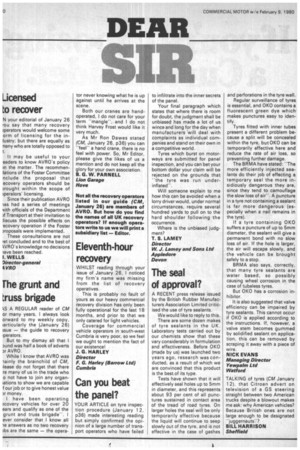The seal of approval?
Page 42

If you've noticed an error in this article please click here to report it so we can fix it.
A RECENT press release issued by the British Rubber Manufacturers Association Limited criticised the use of tyre sealants.
We would like to reply to this.
There are some dozen makes of tyre sealants in the UK. Laboratory tests carried out by our chemists show that these Vary considerably in formulation and effectiveness. Before OKO (made by us) was launched two years ago, research was conducted, as a result of which we are convinced that this product is the best of its type.
Tests have shown that it will effectively seal holes up to 5mm in diameter, and this represents about 93 per cent of all punctures sustained in contact area of the tread of road tyres. On larger holes the seal will be only temporarily effective because the liquid will continue to seep slowly out of the tyre, and is not effective in the case of gashes and perforations in the tyre wall.
Regular surveillance of tyres is essential, and OKO contains a fluorescent green dye which• makes punctures easy to identify.
Tyres fitted with inner tubes present a different problem because a split will be concealed within the tyre, but OKO can be temporarily effective here and reduce the rate of air loss, so preventing further damage.
The BR MA have stated: "The more efficiently injected sealants do their job of effecting a temporary seal the more insidiously dangerous they are, since they tend to camouflage the slow loss of air". A puncture in a tyre not containing a sealant is far more dangerous (especially when a nail remains in the tyre).
If a tyre containing OKO suffers a puncture of up to 5mm diameter, the sealant will give a permanent bond with no slow loss of air. If the hole is larger, the air will escape slowly, and the vehicle can be brought safely to a stop.
BRMA also says, correctly, that many tyre sealants are water based, so possibly causing wheel corrosion in the case of tubeless tyres.
But OKO has a corrosion inhibitor.
It is also suggested that valve efficiency can be impaired by tyre sealants. This cannot occur if OKO is applied according to the instructions. If, however, a valve stem becomes gummed by solidified sealant on application, this can be removed by scraping it away with a piece of wire, NICK EVANS Managing Director Yewpalm Ltd Watford TALKING of tyres (CM January 12), that Citroen advert on television of a GS steering straight between two American trucks despite a blowout makes me ask: why American vehicles? Because British ones are not large enough to be designated "juggernauts"?
BILL HARRISON Sheffield




















































































































